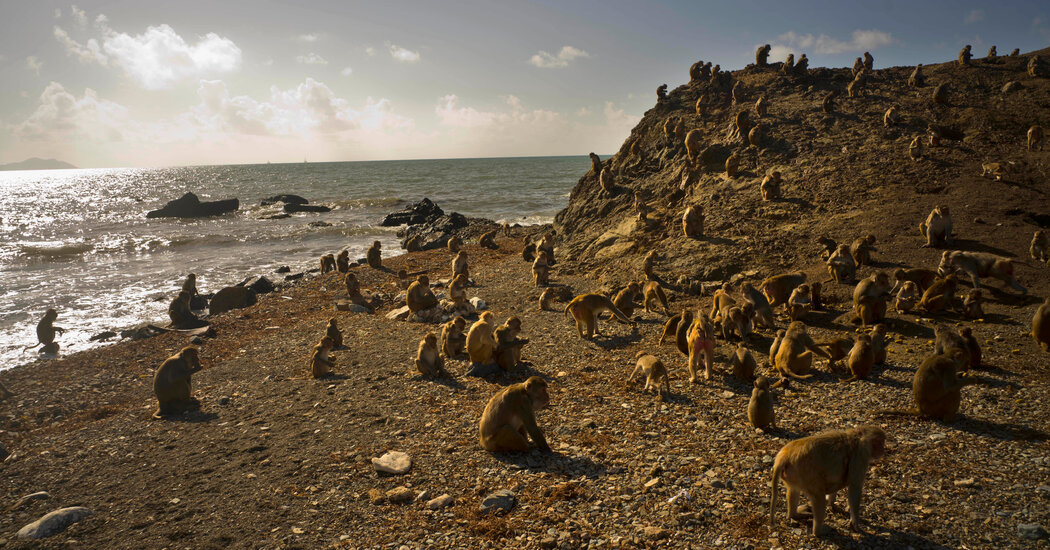Hurricane Maria caused widespread destruction in the Caribbean, not only for people but also for wildlife. Five years after the storm, some effects are still felt.
Cayo Santiago, a small island off the southeast coast of Puerto Rico, is a case in point. It went from a lush jungle oasis to a desert-like sand plain of mostly skeletal trees almost overnight.
This posed a major problem for the macaques that live on the island. The monkeys rely on shade to stay cool in the tropical heat of the day, but by wiping out the trees, the storm had made that resource very scarce.
Rhesus macaques are known to be some of the most quarrelsome primates in the world, with strict social hierarchies maintained through aggression and competition. It would therefore follow that a monkey fight would break out over the few remaining shade spots on the island.
But that’s not what happened. Instead, the macaques did something seemingly inexplicable: they started interacting with each other.
“This was really not what we expected,” said Camille Testard, a behavioral ecologist and neuroscientist at Harvard University. “Instead of becoming more competitive, individuals expanded their social network and became less aggressive.”
An article by Dr. Testard and her colleagues, published on Thursday in the journal Science, offers an explanation for this unexpected development. Monkeys who learned to share shade after the storm, they found, had a better chance of survival than those who continued to argue.
Scientists have documented numerous cases of species responding to environmental pressures with physiological or morphological adaptations. But the new study is among the first to suggest that animals can also respond with persistent changes in their social behavior, Dr. Testard said.
She and her colleagues drew on about a dozen years of data collected at the Cayo Santiago Field Station, the world’s longest-running primatology field site. Researchers introduced rhesus macaques to the 95-acre (38-hectare) island in 1938 and have been studying them ever since.
The approximately 1,000 macaques that live on the island are free-ranging, but are fed by field station staff. “Access to food is not the main point of contention,” Dr. Testard said. “Shade to prevent heat stress is.”
Daytime temperatures on Cayo Santiago often rise above 100 degrees Fahrenheit, or about 38 degrees Celsius, which can be deadly for monkeys stranded in the sun.
After Hurricane Maria wiped out most of the island’s trees, Dr. Testard and her colleagues that macaques would invest more in forming close alliances so they could join forces to get shade. But the “complete opposite” happened, she said. Monkeys instead invested in looser partnerships with a greater number of animals, and they generally became more tolerant of each other.
Dr. Testard said she suspected this was because fighting is an energy-intensive activity that generates more body heat and poses more danger to individuals than “just caring less about whether there’s another monkey sitting next to me or not.”
During the hottest hours of the afternoon, researchers saw macaques huddled in thin strips of shade. But even when temperatures were less oppressive, the animals gathered in larger groups compared to their pre-storm habits, Dr. Testard said.
Not all monkeys jumped on the peace bandwagon, but those who indulged in aggression likely paid a high price. The overall mortality rate of the macaque population did not change after the hurricane. But monkeys that had more friendly relationships experienced a 42 percent lower risk of death because they were less likely to suffer from heat stress.
“Who dies and for what reason, that’s what has changed,” Dr. Testard said.
Noa Pinter-Wollman, a behavioral ecologist at the University of California, Los Angeles, who was not involved in the study, said the “fascinating” findings are “a wonderful example of how being social can mitigate the negative effects of environmental change.” soften.”
Julia Fischer, a behavioral biologist at the German Primate Center in Göttingen who was also not involved in the work, added that the “extremely well-done study” highlighted the importance of behavioral plasticity in helping animals survive when their habitats are turned upside down. “In the light of climate change, this is extremely important,” she said.
Whether other animals can also respond to environmental changes by adapting their social norms “will be very species and context dependent,” said Dr. Testard. However, humans probably fall into that category. People often come together, for example after natural and man-made disasters.
Dr. However, Testard added that there are limits. If resources become too scarce, humans may descend into a Mad Max-like dystopia of violent competition. “There is hope that we work together to make things work instead of fighting,” she said. “But that’s a big speculation.”


